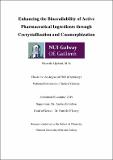| dc.description.abstract | During drug research and development, improving the solubility of poorly water soluble drugs without chemically modifying the drug molecule is one of the biggest challenges for the pharmaceutical industry. Most medicines are formulated as solid dosage forms like tablets and capsules. Cocrystallization and coamorphization are attractive strategies to enhance their dissolution rates and to reduce the number of medications a patient must take.
The aim of this project was to understand the dissolution behaviour and the relationship between dissolution rate, packing index and lattice energy of selected cocrystals. In addition, possible coformulations of antidiabetic and antihypertensive drugs were investigated. Many diabetic patients have coexistent hypertension, which increases the risk of macro- and microvascular complications such as coronary heart disease, retinopathy and nephropathy. All drugs for therapeutic use are formulated with excipients, these excipients often have functional groups that are capable of H bonding. In this thesis cocrystal-excipient compatibility was also investigated.
Chlorothiazide (CTZ) is a short-acting thiadiazine diuretic. It is a Biopharmaceutics Classification System (BCS) class IV drug, indicating low solubility and permeability. In this study, cocrystals and a CTZ salt were obtained by ball milling, followed by crystallization from solution. X-ray diffraction techniques indicated 13 coformers produced cocrystals upon milling, eight cocrystals were crystallized, and enhanced dissolution properties were observed in three cases. Moreover, there was a correlation between the crystal packing index, lattice energy and dissolution rate.
Sulfamethoxazole (SMZ) is an antibiotic that is used to treat urinary tract infections. It is a BCS class IV drug with low solubility and low permeability. The formation of cocrystals and coamorphous forms were examined using mechanical grinding and crystallization from solution. Thirteen coformers gave new crystalline X-ray powder patterns and four gave X-ray amorphous patterns. The aim of this work was to understand the factors that control SMZ cocrystal and coamorphous formation and to determine their associated relevant physical properties. The dissolution rates of the cocrystals were all lower than SMZ forms I and II despite the fact that they have lower computed lattice energies than SMZ forms I and II.
Gliclazide (GLZ) has been shown to be effective in the long-term treatment of diabetes mellitus. It is a class II API, exhibiting low solubility. Patients being treated for diabetes mellitus often exhibit high blood pressure. Drug-drug cocrystals and coamorphous systems containing antidiabetic drugs and hypertension drugs such as triamterene (TRI) and hydrochlorothiazide (HTZ) offer interesting opportunities for combination therapy. In this study, coamorphization of GLZ-TRI with 15 % sodium taurocholate (NaTc) gave a viable coamorphous formulation with an enhanced dissolution rate
Vanillin and vanillate esters are widely used as flavourings in the food industry and the vanillin derivative zingerone is one of the compounds found in the spice ginger. While cocrystal formation of these compounds was the desired outcome, the unsuccessful cocrystallization attampts yielded crystal structures of zingerone, methyl vanillate and ethyl vanillate which were previously unknown. Neither the growth of single crystals of these compounds nor their crystal structures have been reported. In this thesis, a detailed study of the crystallization of methyl vanillate, ethyl vanillate and zingerone is described and the relationship between crystal growth, habit and intermolecular interactions in the crystal lattice is discussed.
In pharmaceutical production, cocrystals are usually formulated with excipients, which may compete with the coformer for hydrogen bonding; therefore, it is important to study the stability of cocrystals in the presence of excipients. In this study, isolated cocrystals were mixed with PVP and MCC, two common excipients, and then milled and kept at 56% relative humidity (RH). The results suggested that it is possible to form cocrystals in the presence of excipients, which would simplify the pharmaceutical process. | en_IE |


